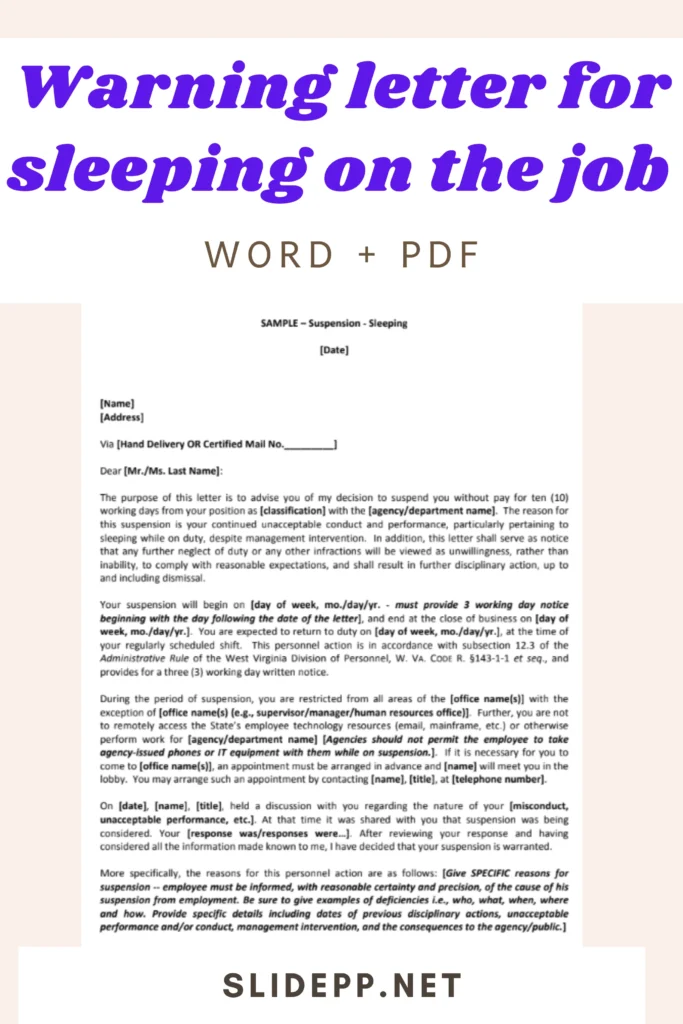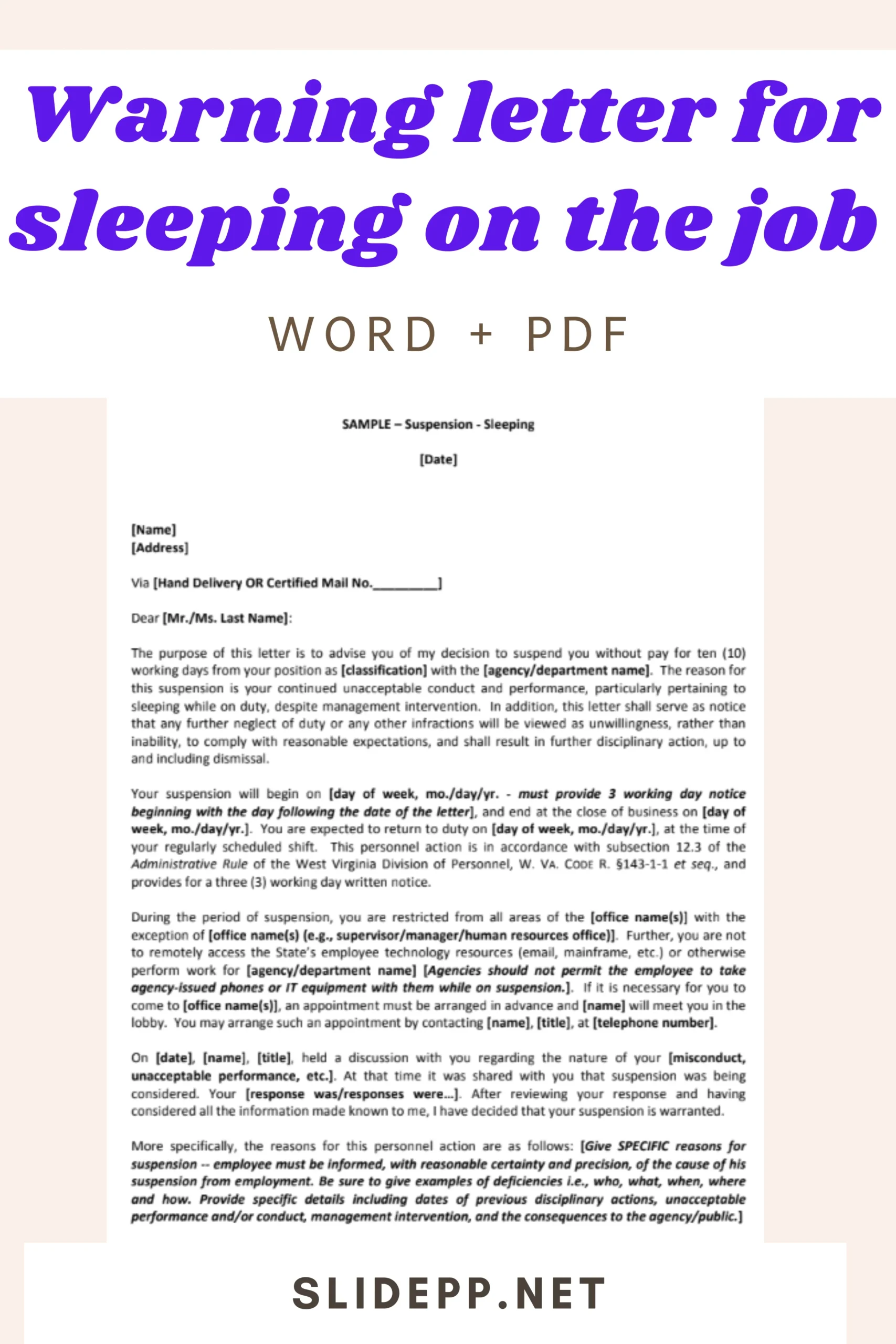Access a sample warning letter for sleeping on the job – Doc and PDF. Handle disciplinary action for sleeping on the job with tips on prevention and legal steps.

Ever walked into the office and spotted a colleague slumped over their keyboard, eyes shut tight? Or maybe you’ve battled that heavy-lidded fog after a rough night? In 2025, with 66% of employees reporting burnout at an all-time high, workplace fatigue is more than a minor hiccup—it’s a major hurdle. This isn’t just about lost productivity; it can spark accidents, especially in roles like driving or operating machinery. The National Safety Council reveals that 97% of workers have at least one fatigue risk factor, amplifying the need for proactive measures.
That’s why we’re zeroing in on the sample warning letter for sleeping on the job – Doc and PDF. As an HR pro or manager, having a solid tool to address caught sleeping during working hours can turn potential chaos into constructive dialogue. This guide will walk you through the whys and hows: from understanding root causes like poor sleep habits to crafting an effective warning letter for sleeping on duty. We’ll tease out key sections on legal considerations, prevention tips, and even a downloadable template in both Doc and PDF formats for easy editing in Word or your preferred viewer.
Picture this: Instead of knee-jerk reactions, you use a professional disciplinary action for sleeping on the job to motivate change. We’ll answer burning questions like “What should a sample incident report sleeping while on duty include?” and share unique astuces, such as quick energy boosts for shift workers. By the end, you’ll feel empowered, like a coach guiding your team to peak performance—alert, engaged, and thriving. Let’s dive in and wake up your workplace strategies!
Understanding the Roots of Workplace Drowsiness
Why Employees Nod Off on Duty
Fatigue doesn’t sneak up without reason. In high-stress 2025 workplaces, where 52% of employees report burnout in the past year, factors like irregular shifts and personal stressors play a big role. Mayo Clinic highlights inconsistent sleep schedules and caffeine overload as top culprits, disrupting your body’s natural rhythm and leading to daytime slumps.
For roles like a security guard sleeping while on duty, the stakes are higher—night shifts throw off circadian clocks. Common triggers include:
- Sleep disorders like apnea, affecting millions.
- Long commutes or family demands cutting into rest.
- Poor diet, with heavy meals causing post-lunch dips.
Recognizing these helps shift from blame to support, preventing recurrence.
The Ripple Effects on Teams and Operations
Beyond the individual, sleeping on the job ripples out. Businesses lose $322 billion annually in productivity from burnout alone, not counting healthcare costs up to $190 billion. For employees, it erodes trust and can lead to job insecurity.
Yet, there’s hope. Addressing it early with a warning letter for sleeping on duty PDF fosters accountability. Studies show fatigue ups injury risks by 1.62 times, so tackling it head-on safeguards everyone. Think of it as investing in your team’s well-being for long-term gains.
Deciding When to Issue a Formal Warning
Not every yawn calls for action, but repeated incidents? Absolutely. Consider the context: A one-time slip might warrant a chat, but for high-risk jobs, like caught sleeping during working hours in transport, it’s critical.
Legally, sleeping while on duty counts as gross misconduct, potentially grounds for dismissal. However, investigate first—health issues could make it unfair. Ask: “Is this disciplinary action for sleeping on the job justified?”
Steps to evaluate:
- Gather evidence, like witness statements.
- Review policies and past performance.
- Offer a meeting to hear their side.
- Document via a sample incident report sleeping while on duty.
This ensures fairness and compliance.
Crafting Your Warning Letter Effectively
Essential Components for Clarity
A strong warning letter for sleeping on duty sets clear boundaries. Include the incident details, policy breached, and improvement plan. Make it supportive: “We value you—let’s fix this together.”
Key elements:
- Date and employee details.
- Factual description without judgment.
- Timeline for change.
- Potential next steps if ignored.
Download our sample warning letter for sleeping on the job – Doc and PDF to start.
Tailoring for Your Workplace
Customization is key. For a security guard sleeping while on duty, emphasize safety risks. Question: “How do I adapt a warning letter for sleeping on duty PDF?” Add specifics like shift times or training offers.
Use Word’s Doc format for easy edits, then save as PDF for sharing.
Sample Warning Letter Template
Ready for action? Here’s our template—download the sample warning letter for sleeping on the job in Doc and PDF from the link below.
Subject: Official Warning for Sleeping During Work Hours
Dear [Employee Name],
On [Date], you were observed sleeping at [Location], violating our attendance policy. This impacts team safety and output.
We appreciate your efforts and suggest resources like sleep workshops. Improve by [specific actions]. Further incidents may lead to escalation.
Best, [Your Name] [Position]
This draws from best practices for balance. Always get acknowledgment.
Strategies to Prevent Drowsiness at Work
Employee-Focused Tips
Beat the slump personally. Mayo Clinic recommends 7-9 hours of consistent sleep—stick to a schedule. Hydrate, walk briefly, or splash cold water for instant alerts.
Quick wins:
- Exercise upon waking.
- Limit caffeine post-noon.
- Nap strategically if shifting.
“How can I avoid sleeping on the job?” Start with a balanced diet—skip sugary snacks.
Employer Best Practices
Leaders, create a fatigue-proof culture. Offer flexible schedules and breaks— even naps for night shifts. Educate via workshops.
Prevention Table:
| Strategy | How It Helps | Example |
|---|
| Optimal Lighting | Boosts alertness | Bright workspaces |
| Scheduled Breaks | Reduces buildup | 10-min walks |
| Sleep Education | Empowers habits | Mayo Clinic resources |
These cut risks, minimizing warnings.
Navigating Legal and Ethical Angles
Before acting, mind the law. Sleeping on duty can justify termination, but probe for disabilities—accommodate if needed. Ethically, view it as a wellness issue.
Link to Wikipedia for misconduct overviews (en.wikipedia.org/wiki/Sleeping_while_on_duty). Build empathy: Offer EAPs for underlying causes.
Conclusion
In summary, with 2025 seeing 80% of employees at burnout risk, tackling sleeping on the job is vital. We’ve unpacked causes from Mayo Clinic tips, when to use a warning letter for sleeping on duty, and our sample warning letter for sleeping on the job – Doc and PDF for downloads in Word and PDF. Prevention, like consistent sleep and breaks, plus fair disciplinary action for sleeping on the job, creates safer spaces.
Take charge now! Grab the template, apply these astuces, and watch your team energize. Whether it’s a sample incident report sleeping while on duty or handling caught sleeping during working hours, you’re set. Drop a comment: What’s your top tip for staying alert? Share this post to help others—let’s build better workplaces together.
👀👉👉[🔗 Download Word]
👀👉👉[🔗 Download Word]
👀👉👉[🔗 Download pdf – warning letter]
👀👉👉[🔗 Download pdf – suspension]


